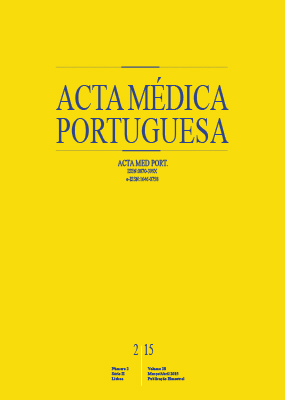Comparing the Application of Hema-Obs RSS to 250 Pregnancies from Obstetrics/Hematology Consultation in Centro Hospitalar São João, Portugal with the Application of Galit Sarig RSS to 90 Pregnancies from Rambam Health Care Campus, Israel
DOI:
https://doi.org/10.20344/amp.5200Keywords:
Comparative Study, Israel, Portugal, Pregnancy, Risk Assessment comparative study, Thrombophilia.Abstract
Introduction: Pregnant women with thromboembolic diseases, previous thrombotic episodes or thrombophilia family history were supervised in a multidisciplinary Obstetrics/ Hematology consultation in Centro Hospitalar São João EPE, Porto, Portugal. For the evaluation and medication of these women, a risk stratification scale was used.Purposes: The aim of this study was to validate a Risk Stratification Scale and thromboprophylaxis protocol by means of comparing it with a similar scale, developed and published by Sarig.
Material and Methods: We have compared: The distribution, by risk groups, obtained through the application of the two scales on pregnant women followed at Centro Hospitalar São João, Porto, Portugal, consultation; the sensibility and specificity for each one of the scales (DeLong scale, applied to Receiver Operating Characteristic) curves; the outcomes in pregnancies followed in Hospital São João, Porto, Portugal
Results: According to our Hema-Obs risk stratification scale, 29% were allocated to low-risk, 47% to high-risk and 24% to very-high-risk groups. According to Galit Sarig risk stratification scale, 24% were considered low-risk, 53% moderate, 16% high-risk and 7% as very high-risk group. In our study we observed 9% of spontaneous abortions, in comparison with 18% in the Galit Sarig cohort. From the application of Receiver Operating Characteristic curve to both risk stratification scales, the results of the calculated areas were 58,8% to our Hema-Obs risk stratification scale and 38,7% to Galit Sarig risk stratification scale, with a Delong test significancie of p = 0.0006.
Conclusions: We concluded that Hema-Obs risk stratification scale is an effective support for clinical monitoring of therapeutic strategies.
Downloads
Downloads
Published
How to Cite
Issue
Section
License
All the articles published in the AMP are open access and comply with the requirements of funding agencies or academic institutions. The AMP is governed by the terms of the Creative Commons ‘Attribution – Non-Commercial Use - (CC-BY-NC)’ license, regarding the use by third parties.
It is the author’s responsibility to obtain approval for the reproduction of figures, tables, etc. from other publications.
Upon acceptance of an article for publication, the authors will be asked to complete the ICMJE “Copyright Liability and Copyright Sharing Statement “(http://www.actamedicaportuguesa.com/info/AMP-NormasPublicacao.pdf) and the “Declaration of Potential Conflicts of Interest” (http:// www.icmje.org/conflicts-of-interest). An e-mail will be sent to the corresponding author to acknowledge receipt of the manuscript.
After publication, the authors are authorised to make their articles available in repositories of their institutions of origin, as long as they always mention where they were published and according to the Creative Commons license.









